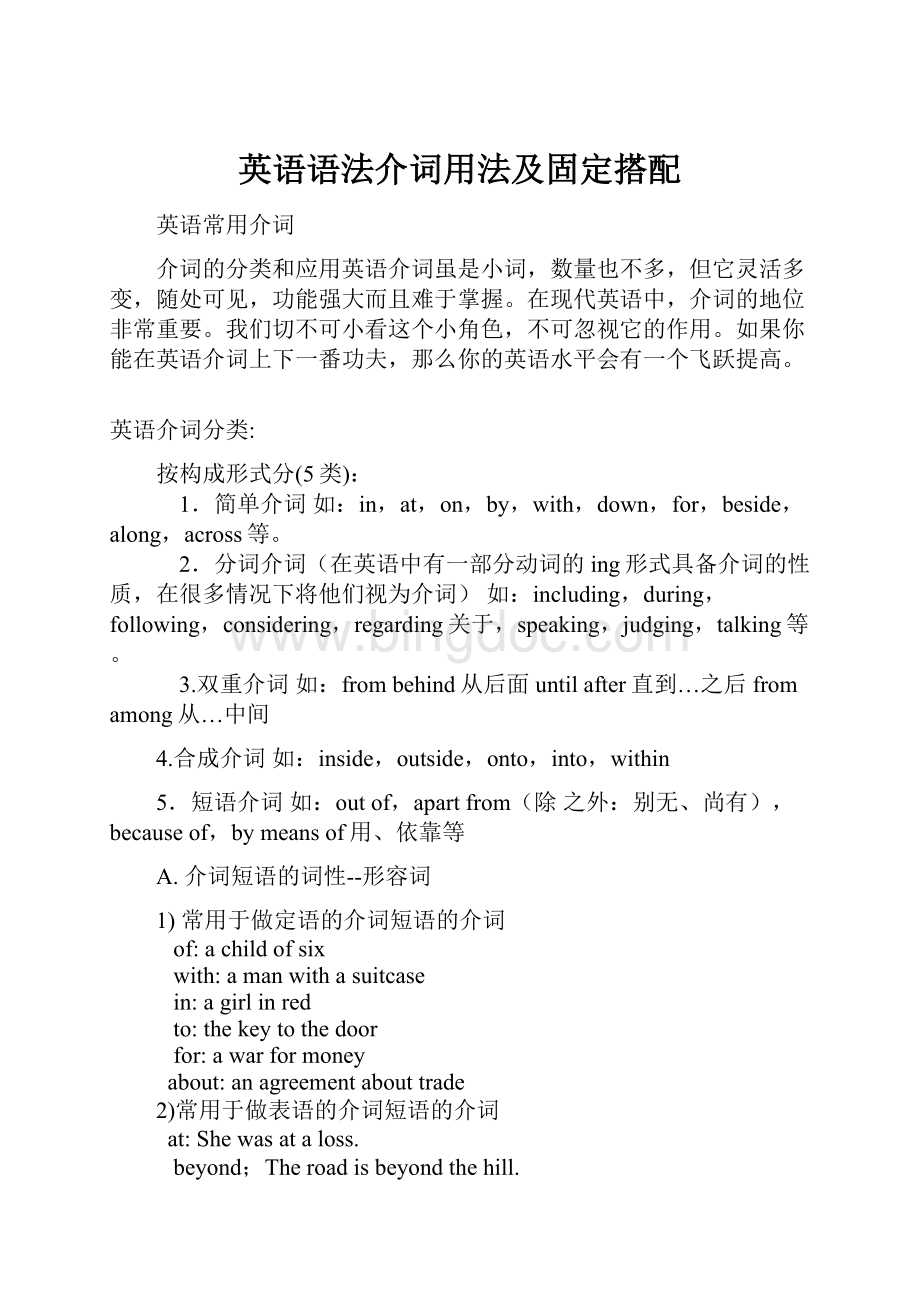英语语法介词用法及固定搭配.docx
《英语语法介词用法及固定搭配.docx》由会员分享,可在线阅读,更多相关《英语语法介词用法及固定搭配.docx(15页珍藏版)》请在冰点文库上搜索。

英语语法介词用法及固定搭配
英语常用介词
介词的分类和应用英语介词虽是小词,数量也不多,但它灵活多变,随处可见,功能强大而且难于掌握。
在现代英语中,介词的地位非常重要。
我们切不可小看这个小角色,不可忽视它的作用。
如果你能在英语介词上下一番功夫,那么你的英语水平会有一个飞跃提高。
英语介词分类:
按构成形式分(5类):
1.简单介词如:
in,at,on,by,with,down,for,beside,along,across等。
2.分词介词(在英语中有一部分动词的ing形式具备介词的性质,在很多情况下将他们视为介词)如:
including,during,following,considering,regarding关于,speaking,judging,talking等。
3.双重介词如:
frombehind从后面untilafter直到…之后fromamong从…中间
4.合成介词如:
inside,outside,onto,into,within
5.短语介词如:
outof,apartfrom(除之外:
别无、尚有),becauseof,bymeansof用、依靠等
A.介词短语的词性--形容词
1)常用于做定语的介词短语的介词
of:
achildofsix
with:
amanwithasuitcase
in:
agirlinred
to:
thekeytothedoor
for:
awarformoney
about:
anagreementabouttrade
2)常用于做表语的介词短语的介词
at:
Shewasataloss.
beyond;Theroadisbeyondthehill.
in:
He’sstillindanger.
of:
It’sofnovalue.
on:
Heisonguard.值班
outof:
I’moutofjob.
under:
He’sunderforty.
3)用于做宾语补足语:
IsawGeorgeatwork.
Acoldkepthiminbedfor7days.
B.介词短语的词性—副词
1)做状语,主要用于修饰谓语:
HehasbeenheresinceMonday.
Bakeitisfortwohours.
2)用于be+adj.结构:
Sheisafraidofsnakes.
I’msorryaboutthat.
3)修饰非谓语动词:
Iaskedtospeaktotheheadmaster.
介词--短语动词中的关键角色 含有介词的短语动词
1.v.+prep:
agreewith/to/on/in,answerfor,askfor,comeacross,goafter,liveon,runinto,headfor,lookfor/after/at等。
2.v.+adv.+prep:
comeupto达到,goinfor从事、爱好,runoutof,用光doawaywith废除,keepupwith,makeupfor,putupwith等
按表达意义分(3类):
1.时间介词,如:
at,on,in,during,over,from,for,until等。
2.地点介词,如:
at,on,in, across,to,over,between,inside,outside等。
3.其它介词,如:
by,with,about,except,insteadof,dueto,apartfrom等。
(一)表示时间的介词:
1.at,on,in
(1)at表示具体“在某一时刻、某一时点”或者把某一短时间看做某一时刻
at5:
30在5:
30 atsunrise日出时 atnight夜间
atnoon正午时 atmidnight在半夜
atlunch午饭时atbreakfast在吃早饭时
atfirst首先atthebeginning(of……)在…开始时
atlast最后attheend(of……)最后
atthemoment当时atpresent目前
atthattime在那时atChristmas在圣诞节
attheageof…在…岁时
(2)on表示“在具体某一天或某天的上、下午、早上、晚上”
onMonday在星期一 onApril1st(onAprilthefirst)在四月一日
onMondaymorningontheweekend在周末
onthefollowingday第二天onthefollowingdayevening第二天晚上
onNewYear’sDay在元旦onschooldays在校期间onschool’sday在校庆日
onarainyday在雨天onacoldday在寒冷的一天
泛指上、下午、晚上、夜间时用inthemorning/afternoon/evening,atnight;但若指具体某一天的上述时段时,则一律用on。
如:
OntheafternoonofMay23.在五月二十三日下午。
IheardashotonthemorningofMarch18.三月十八日早晨我听到一声枪响。
(3)in表示【泛指的上、下午、晚上】【在某月、季节、年、世纪】【表示将来时间翻译成“在……之后”】
inthemorning/afternoon/evening在上午/下午/晚上
inSeptember 在九月 inwinter 在冬季
in1999 在1999年 inthe20th(21st)century 在20(21)世纪
inone’slife在某人一生中intwoweeks两周后inthefuture在将来
inthedaytime在白天inmyschooldays在我上学期间
2.for,during,through
(1)for“长达…之久”(表示过了多长时间)后接一段时间(与数词连用的时间名词)
多与完成时连用。
I’vebeenasoldierfor5years.我入伍已5年了。
Shehasbeenillforseveraldays.她已经病了几天了。
表示“持续一段时间”时,for后面必须跟“数字+时间名词”,而during后决不可接数字。
(2)during表示“在……期间”
duringthenight在晚上duringthefire在发生大火期间
duringthemeeting在开会期间duringthemeal在吃饭过程中
Hevisitedmanyniceplacesduringhisstayhere.在他逗留期间他参观了许多美丽的地方。
Whatdidyoudoduringthesummervacation?
你在暑假做了什么?
(3)through表示“一直……,自始至终”
Theyworkedhardthroughthewinter.整个冬天他们都在努力工作。
Shetreatedmelikeherbrotherthroughtheseyears.这些年来她始终把我当哥哥对待。
3.from,since
(1) from表示“等时间的起点”,作“从……”解,多用于“from…to/till…”中。
YoucancomeanytimefromMondaytoFriday.周一至周五你什幺时间来都行。
Theexamwillstartfrom9:
00am.考试将从上午九点开始。
①from“从……(开始)”未必持续到现在,如:
from1995to1998.从1995年到1998年。
”
②since而since是指“自从……以来一直持续到现在
一般只与现在完成时连用,而from不受此限。
(2)since表示“自从……以来(直到现在)”
Hehasbeenawayfromhomesince1973.他自从1973年就离开了家乡。
Wehaveknowneachothersincetenyearsago.我们十年前就认识了。
for与since表示一段时间,但for与时间段连用,而since与时间点连用。
如fortwohours(持续)两小时;sincelastweek自从上周直到现在
4.before,by,till,until
(1)before指“在……之前”
Pleasecomebeforeteno’clock.请10点以前来。
Themeetingwillendafter3:
00pm. 会议将在下午三点后结束。
表示“在……以前”时,before与by基本可通用。
但by还有“最晚不迟于…”“截至……为止”之意,此时可与完成时(现在完成、过去完成)连用,而before一般不与完成时连用。
如:
Howmanymodelshaveyoumadebytheendoflastmonth?
截至上月底你做了多少个模型?
(2)by指“不迟于,到……时为止,在……以前”动作完成
Imustfinishmyhomeworkbylunch.午饭前我必须做完作业。
Wehadlearnedover1000wordsbytheendoflastterm.
到上学期末为止,我们已经学了1000多个单词了。
(3)till(until)“直到……为止”动作持续到什么时候
Youmustwaitforhimtilltomorrow.你必须一直等到他明天。
Hedidn’tcomebackuntiltwelveo’clocklastnight.他昨晚下到12点才回来。
在肯定句中,till(until)必须与延续动词连用。
若与点动词连用,till(until)只能用于否定句中。
5.after, in, within
①after表示“在……之后”,是before的反义词。
We’llholdapartyafterdinner.晚餐后我们将举办晚会。
Hegotacanceranddiedafterayear.他患了癌症,一年后去世了。
I’llphoneyouafterIarrive.到达后我给你打电话。
(after作连词)
②within“在……时间之内”
Icanfinishitwithinanhour.我不出一小时就可把它做完。
比较 after与in
①after后可跟时间段,也可跟时间点,如afterschool(放学后),
而in后必须跟一段时间,如inanhour(一小时后)。
②after既可用于将来时,也可用于过去时,而in只能用于将来时。
③after既可作介词,又可作连词,而in只能作介词②in“在……时间之后”
I’llarriveinanhour.我一小时后到达。
we’llmeetagainintwoweeks我们将会在两周以后再见
WestartedoutfortheUnitedStatesonJulythefirstandafter20hours,WearriveatLosAngelesAirport我们7月1日出发20小时后我们到达洛杉矶机场
Nextweekwe’regoingonatriptoHongKongandafteraboutaweek,we’revisitingMalaysia下周我们去香港旅游,大约一周后我们访问马来西亚
in与within后都必须跟时间段。
(二)表示“地点、方向”的介词:
1、表示地理方位的介词的用法:
in
表示A地在B地范围之内。
如:
Taiwan is in the southeast of China.
to表示A地在B地范围之外,即二者之间有距离间隔。
如:
Japan lies to the east of China.
on表示A地与B地接壤、毗邻。
如:
North Korea is on the east of China.
off表示“离……一些距离或离……不远的海上”。
如:
They arrived at a house off the main road.
New Zealand lies off the eastern coast of Australia
2.inoutsidebetween,among
①in表示“在……里面”,如:
What’sinthebox?
盒子里是什么?
Sheputherbookinthedesk.她把书放进了书桌。
②outside指“在……外面”
Therearemanypeopleoutsidetheroom.房间外有很多人。
Whatdidyourseeoutsidethehall?
你在大厅外看见了什么?
③between在……之间(指二者)
Thereisahospitalbetweenthehotelandthepostoffice.在宾馆与邮局之间有所医院。
Thebuildingstandsbetweentheparkandthesmallriver.那栋建筑位于公园和小河之间。
between是指“在两者之间”,而among指“在多个之间”。
④among在……之间(指三者以上)
“Thereisathiefamongyou.”Thepolicemanshoutedtothecrowd.
警察向人群喊道:
“你们中间有个小偷!
”
Hefoundhisplaceamongthecrowd.他在人群中找到了他的位置。
3.on,above,over,below,under
(1)on在……上面,表面相互接触。
Thereisanappleonthetable.桌上有一个苹果。
Onthetopofthehill,thereisaflag.山顶有一面旗子。
(2)above只表示“在……上方或位置高出……”,与below相对。
Aplaneflewaboveourheads.一架飞机从我们头上飞过。
TheTurnersliveaboveus.特纳一家人住在我们的上面。
(3)over“在……正上方”,与under相对。
Thereisabridgeovertheriver.河上有一座桥。
Thepictureishangingovertheblackboard.那张图挂在黑板的正上方。
(4)below在……下方,低于……
Therearemanyflowersbelowthewindow.窗下有很多花。
Herskirtreachesjustbelowherknees.她的裙子刚到膝盖下。
(5)under在……正下方
Theysatunderabigtree,drinking.他们坐在一棵大树下喝酒。
Whatareyouwearingunderyourcoat?
你外套里面穿了什么?
4.near,by,beside
(1)near在……附近,与far相对
Ahospitalwasbuiltneartherailwaystation.在火车站附近建了一所医院。
Myhomeisnearheschool.我的家离学校很近。
(2)by=beside,靠近,在……旁边,比near距离更近
Hejustsatby/besidemeinthecinema.在电影院他就坐在我旁边。
Helaydownbesidethestatuary.他在雕像旁躺下了。
5.infrontof,behind,around(round、about通用表示围绕某物体,或者表示时间“大约”)
(1)infrontof在……前面
Ariverflowsinfrontofthehouse.房子前有一条河
Theyputabunchofflowersinfrontofthedoor.他们在门前放了一束花。
inthefrontof表示“在……前部”,指里面。
Thereisaredchairinthefrontoftheroom.在房间前半部有把红椅子。
(2)behind在……后面
Ahighbuildingstandsbehindthevillage.村子后面有一高层建筑。
Thecatliesbehindthedoor.猫躺在门后面。
(3)around在……周围,围绕
Therearemanytreesaroundthevillege.村子周围有很多树围绕。
Thereareflowersaroundthestage.舞台周围摆着鲜花。
6.from,to,for,into,outof
(1)from从……
ThetrainstartedfromParis.火车发自巴黎。
ShewillflyfromBeijingtoHongkong.她将从北京飞往香港。
(2)to到……(目的地)去,向……
HewenttoGermanylastyear.他去年去了德国。
Theygottothetownverylate.他们很晚才到那个镇。
(3)for向……,表目的方向
HeleftforTianjinonbusinessyesterday.他昨天出差去天津了。
ThetrainforShanghaihasbeenaway.去往上海的火车已经开走了。
towards,to和for都可表示“向……”,其区别如下:
①towards仅指朝向某个方向,不一定是目的地,而to和for都是“向目的地”。
②for作“向(目的地)”时,常用于固定搭配中,如:
leavefor;startfor
(4)into进入
Pleaseputthewaterintothebottle.请把水倒入瓶子里。
Theteachercameintotheclassroomwithasmile.老师微笑着走进了教室。
(5)outof从……出来
Abeautifulgirlinredwentoutoftheshop.一个穿红衣服的漂亮女孩从商店里走了出来。
Theypulledhimoutofthewater.他们把他从水里拉了出来。
7.along,across,through,past,over
(1)along沿着
Helikestodrivealongtheriver.他喜欢沿着河开车。
Thereareallkindsofbeautifulflowersalongtheroadstreet.沿街有着各种美丽的花。
(2)across横穿(平面物体)
Thelittlegirlisafraidtogoacrossthestreet.这个小女孩不敢横穿马路。
It’sdangeroustorunacrossthebusyroad.跑着穿越繁忙的马路是很危险的。
(3)through穿过空间内通过(穿过森林、沙漠、穿过窗户)
Ittookustenminutestodrivethroughthetunnel.开车穿过这条隧道花了我们10分钟时间。
Hepushedhiswaythroughthecrowdtotheplatform.他从人群里挤到了站台。
(4)past经过从事物的一旁经过
8.at,in
二者都表示“在某个地方”,但at多指较小的地方,如车站、家等,而in多指在“大地方”,如城市、国家、大洲等。
(但大小有时也是相对的)。
HelivesatNo.27ZhongshanstreetinNanjing.他住在南京市中山路27号。
TheplanewillarriveinBeijingat13:
00.飞机将于13点到达北京。
(三)其它用途的介词:
1.表示“标准或单位”的介词:
at,for,by
(1)at表示“以……速度”“以……价格”
Hedroveataspeedof80milesanhour.他以每小时8英里的速度行驶。
Isoldmycaratahighprice.我以高价出售了我的汽车。
(2)for用……交换
Iboughtitfor20dollars.买它花了我20美元。
Howmuchfortheseapples?
这些苹果多少钱?
at与for都表示价格,但at表示“单价”,for表示总价,at后一般跟“price”这个词,而for后只能跟总钱数。
如:
Iboughtitatalowprice.